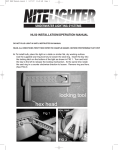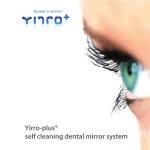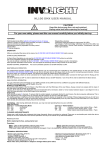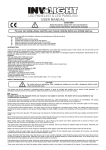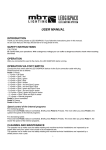Download NL50 USER MANUAL
Transcript
NL50 USER MANUAL CAUTION! Keep this device away from rain and moisture! Unplug mains lead before opening the housing! For your own safety, please read this user manual carefully before you initially start-up. FEATURES *LED flower effect in RGB and white Beams from the 4 lenses *DMX-512 control via regular DMX-controller (occupies 6 channels) *Sound-controlled via built-in microphone *Microphone-sensitivity adjustable via rotary-control *Strobe effect *8 internal programs *Master/Slave function *Particularly bright illuminating power of the 5mm RGB + white LEDs *Advantages of LED-technology: extremely long life of the LEDs, low power consumption, minimal heat emission, maintenance free with brilliant light radiation OPERATION After you connected the spot to the mains, the device starts running. STAND ALONE OPERATION In Stand Alone Operation you can use the device without a controller. For sound controlled operation set all DIP Switches to OFF. You can do without a controller as the device features a built-in microphone, which provides automatic sound control. You can adjust the sensitivity with the rotary-control on the rear panel. SOUND-CONTROL OPERATION For sound controlled operation set all DIP Switches to OFF. MASTER/SLAVE OPERATION The master/slave-operation enables that several devices can be synchronized and controlled by one master-device. On the rear panel of the device you can find an XLR-jack and an XLR-plug, which can be used for connecting several devices. Choose the device which is to control the effects. This device then works as master-device and controls all other slave-devices, which are to be connected to the master-device via a stereo shielded cable. Connect the OUT-jack with the IN-plug of the next device. Set all DIP Switches to OFF in order to determine the Master device. Set DIP Switches 1 and 10 to ON in order to determine the Slave device. DMX-CONTROL OPERATION You can control the spots individually via your DMX-controller. Every DMX-channel has a different occupation with different features. For DMX-controlled operation set DIP Switch 10 to ON. Building a serial DMX-chain: Connect the DMX-output of the first fixture in the DMX-chain with the DMX-input of the next fixture. Always connect one output with the input of the next fixture until all fixtures are connected. Caution: At the last fixture, the DMX-cable has to be terminated with a terminator. Solder a 120 Ω resistor between Signal (–) and Signal (+) into a 3-pin XLR-plug and plug it in the DMX-output of the last fixture. Addressing Each device occupies 6 channels. To ensure that the control signals are properly directed to each device, the device requires addressing. This is to be adjusted for every single device by changing the DIP-switches as set out in the table below. The starting address is defined as the first channel from which the device will respond to the controller. Please make sure that you do not have any overlapping channels in order to control each device correctly and independently from any other fixture on the DMX data link. If two, three or more devices are addressed similarly, they will work similarly. Occupation of the DIP-switches: Controlling: After having addressed all devices, you may now start operating these via your controller. DMX PROTOCOL Channel 1 – Len 1 - LED groups/colors selection 000 – 010 Off 011 – 016 Group 1 of White on 017 – 022 Group 2 of White on 023 – 028 Group 3 of White on 029 – 034 Group 1 of Red on 035 – 040 Group 2 of Red on 041 – 046 Group 3 of Red on 047 – 052 Group 1 of Green on 053 – 058 Group 2 of Green on 059 – 064 Group 3 of Green on 065 – 070 Group 1 of Blue on 071 – 076 Group 2 of Blue on 077 – 082 Group 3 of Blue on 083 – 088 All White on 089 – 094 All Red on 095 – 100 All Green on 101 – 106 All Blue on 107 – 112 All Red and all Green on 113 – 118 All Red and Blue on 119 – 124 All Green and all Blue on 125 – 130 All Red, all Green and all Blue on 131 – 136 All Red and all White on 137 – 142 All Green and all White on 143 – 148 All Blue and all White on 149 – 154 Group 1 of Blue and all White on 155 – 160 Group 2 of Blue and all Red on 161 – 166 Group 3 of Blue and all Green on 167 – 172 Group 1 of Blue and group 3 of Red on 173 – 178 Group 2 of Blue and group 2 of Red on 179 – 184 Group 3 of Blue and group 1 of Red on 185 – 190 Group 1 of Green and group 3 of White on 191 – 196 Group 2 of Green and group 2 of White on 197 – 202 Group 3 of Green and group 1 of White on 203 – 208 Group 1 of Blue, Group 3 of Green, Group 1 of Red, and group 3 of White on 209 – 214 Group 2 of Blue, Group 2 of Green, Group 2 of Red, and group 2 of White on 215 – 220 Group 3 of Blue, Group 1 of Green, Group 3 of Red, and group 1 of White on 221 – 255 All White, all Red, all Green and all Blue on Channel 2 – Len 2 - LED groups/colors selection DITTO Channel 3 – Len 3 - LED groups/colors selection DITTO Channel 4 – Len 4 - LED groups/colors selection DITTO Channel 5 – Strobe 000 – 010 Off 011 - 255 Flash, with increasing speed Channel 6 – Internal Programs, Auto Mode, Sound Control 000 – 010 No function 011 – 036 Program 1 037 – 062 Program 2 063 – 088 Program 3 089 – 114 Program 4 115 – 130 Program 5 131 – 156 Program 6 157 – 182 Program 7 183 – 208 Program 8 209 – 250 Auto Mode: Internal Programs 251 – 255 Sound Controlled Mode CLEANING AND MAINTENANCE We recommend a frequent cleaning of the device. Please use a soft lint-free and moistened cloth. Never use alcohol or solvents! There are no serviceable parts inside the device except for the fuse. Maintenance and service operations are only to be carried out by authorized dealers. Replacing the fuse If the fine-wire fuse of the device fuses, only replace the fuse by a fuse of same type and rating. Before replacing the fuse, unplug mains lead. Procedure: Step 1: Take out the fuseholder under the power supply. Step 2: Remove the old fuse from the fuseholder. Step 3: Install the new fuse in the fuseholder. Step 4: Replace the fuseholder in the housing and fix it. Should you need any spare parts, please use genuine parts. If the power supply cable of this device becomes damaged, it has to be replaced by authorized dealers only in order to avoid hazards. TECHNICAL SPECIFICATIONS Power supply: 220-250 V AC, 50-60 Hz Power consumption: 30W Number of DMX channels: 6 DMX-512 connection: 3-pin XLR Sound-control: via built-in microphone via built-in microphone Maximum ambient temperature Ta: 45° C Maximum housing temperature TB (steady state): 60° C Min.distance from flammable surfaces: 0.50 m Min.distance to lighted object: 0.10 m Fuse: F 1 A, 250V Weight: 5.5 kg Please note: Every information is subject to change without prior notice. 2



